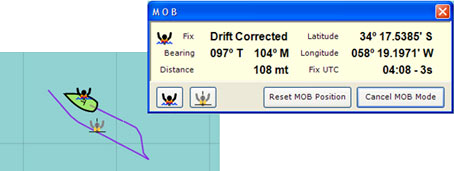Discover EVOLUTION
EVOLUTION is a performance, tactics, and analysis software for racing yachts. Discover what the system can do for you.
Easy to use, you can adopt it at the pace of your team. It is designed without unnecessary complexities. It is highly reliable. It works on any computer running any version of Microsoft Windows.
Main Features
EVOLUTION is packed with powerful functions. It would not be easy to summarize them all in a few lines. Yet, we can detail the main ones in the following areas. Please check each tab.
Performance is one of the essential concepts in any racing yacht. It relates to our ability to sail at the boat’s maximum capacity.
We only consider the boat’s speed through the water when talking about performance. Our position, destination, current flow, wind direction, or other geographical references are irrelevant.
The expected performance (targets) comes from the perceived wind (TWA/TWS) and the boat’s polar curves.
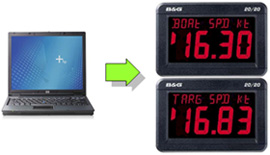
EVOLUTION calculates the following target values and sends them to the instrument’s displays.
- Boat speed target in Optimum VMG mode. This indicator helps us consistently steer at the best VMG in upwind legs.
- Wind angle (TWA) target in Optimum VMG mode. It gives us a reference for sailing at the best VMG in downwind legs.
- Boat speed target for any TWA-TWS. It allows us to know our performance in any navigation condition.
- Difference between the target and the actual heel. This is a hint of incorrect sail trim (over-powered), resulting in excessive leeway,
With these simple targets, the helmsperson and the trimmers can keep the boat at its best in any race condition. For example:
- You can sail at the best VMG by comparing the target against your actual value on upwind or downwind legs.
- After a tack, it is easy to do progressive sail trim while the boat speeds up to its target in the shortest possible time.
- You can avoid sailing above your heel target, giving away unnecessary leeway.
Tactical information is critical when making decisions that take us from one point to another in the shortest possible time.
Unlike performance, tactical data relates to the geographic frames of reference. It uses coordinates, true or magnetic headings, directions, and bearings. Laylines and trajectories are overground and consider the flow of the current.
By setting the “tactic mark” (go-to mark), EVOLUTION yields all the data the tactician needs to make decisions. For example:
- Sailing mode to the tactic mark.
- The time, distance, or angle to the laylines or the tactic mark.
- The tack gives you the fastest tactic mark (VMC) approach.
- Heading and course over the ground for the actual and opposite tack or reaching the tactic mark.
- The recent behavior of the wind and current.
All this data is usually presented on the wireless display on the deck.
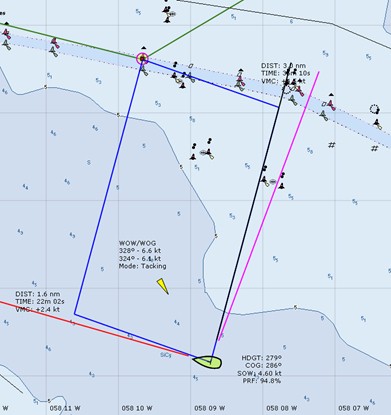
The tactician will have the best information available to make his decisions.
You can also apply these calculations to each segment of the course. This information is crucial for selecting the sails and the strategy for the next leg. Besides the data already mentioned, you can use the following expected data for any course leg:
- Wind angles and speeds, both apparent and real.
- Speeds through the water.
- Time to complete de leg.
In these simulations, you can use the actual wind and current or forecast conditions on each leg.
EVOLUTION presents this information on the nautical chart and a panel in numbers, both in a very easy-to-interpret.
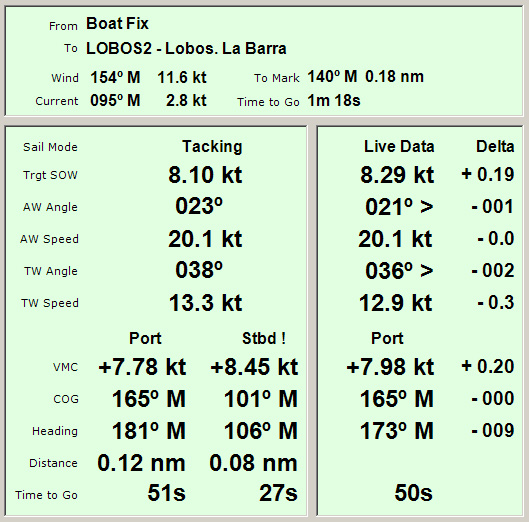
This is the crucial moment in any race. A real challenge where you have to make the right decisions in seconds.
The system provides all the information you need when the starting line is set for a windward, a reach, or a downwind start. Using EVOLUTION’s advanced predictive calculations, the crew can execute a perfect start on the gun at 100% performance.
Multiple Scenarios
EVOLUTION shows the starting line, the boat, and the possible paths to all seven specific starting points on the deck screen. These are:
- The Pin and RC boat.
- Best upwind mode: direct, after tacking, or after gybing.
- On heading.
- The shortest path to the starting line.
In the upper section, for each of these points, you will see the following:
- Distance to the starting line, in meters or boat lengths.
- Time to go: needed to reach the starting line if you speed up now.
- Ratio (time-to-gun/time-to-go). Large ratios imply you will need more time to hold or defend your selected pre-start position.
- Time to burn or late if you speed up now.
The Complete Picture
The following image shows a start 26 seconds from the gun. For each point, we get the distance, the time to go, the time to burn, or the time late if the data is displayed on a black background. With all this data, you have a complete tactical scenario of the start, allowing you to adjust your strategy in a fraction of a second.

In the lower section of the screen, EVOLUTION provides information related to the starting line and the laylines. The items are the following:
- Heading to sail downwind or upwind parallel to the laylines.
- Separation from the boat to the starboard laylines for both ends of the starting line.
- Courses and times to navigate between laylines (length of the starting line).
- True wind direction for which the starting line is set.
- The favored end of the starting line and the related gain.
Precise
To predict the data for each point, EVOLUTION considers the initial boat speed and the time to complete the alignment turn. It also calculates the speed loss when executing this maneuver. Finally, it considers the acceleration to reach the target speed specified by the polar curves.
You can use start-specific polar curves, adjust acceleration, and turn patterns.
Today, EVOLUTION is the best start software available.
Yacht racing navigation is not about knowing where you are but using all available tools to develop strategy and manage risk to get where you want to go as quickly and efficiently as possible.
An essential task in any pre-race routine is crafting a reliable race strategy.
“Strategy” is about how you approach sailing on a given racecourse and using wind shifts, current, and waves to complete the course in the fastest time possible.
Typically, you will collect and organize all the relevant data. You will then evaluate this information to outline a strategy. This process can begin days before the race and take up to minutes before the start signal.
Days before the race, you can use EVOLUTION to:
- Check the behavior of weather systems for the race date and area in previous seasons.
- Get advance forecasts of the weather and currents expected for the regatta area.
- Import tracks based on optimal routing calculations produced by the Predictwind Offshore application.
During the start and sailing in the regatta area, you can:
- Check if the latest forecasts are being met or the strategy needs adjustments.
- Analyze the original strategy against the actual sailing conditions for the next legs.
Numerical Forecast Models
EVOLUTION lets you quickly access the best available forecasts and shows them over the nautical chart. You will get the complete picture of the weather systems’ evolution days in advance.
Even if you are racing in your local waters, EVOLUTION will help with valuable information to:
- Predict the wind and current flow behavior along the course.
- Understand how the geography around the racecourse affects the forecasted conditions.
- Make plans for how to deal with uncertain situations.
You can start working on the expected sailing conditions once you get the “where” and “when” from the race documents.
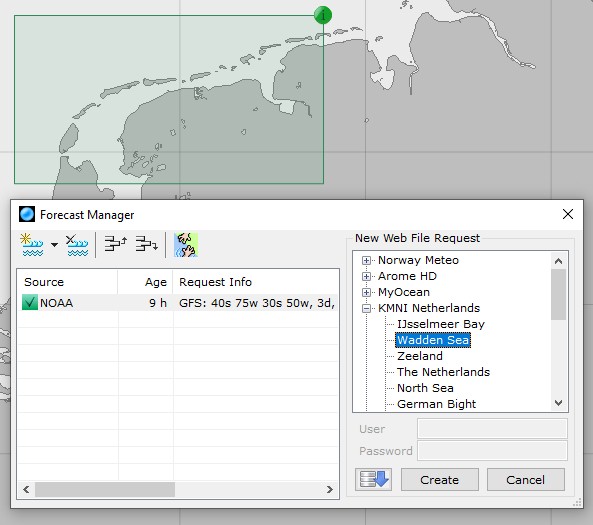
You will have access to various weather, current, and wave forecasts. Some with worldwide coverage. Others refined to a high level of detail for smaller areas.
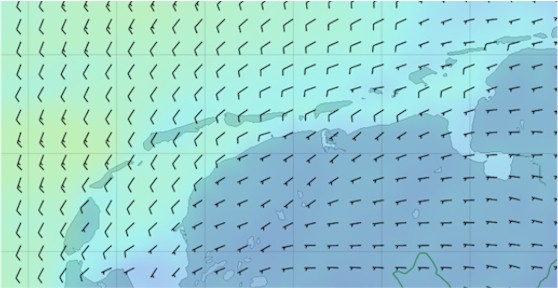
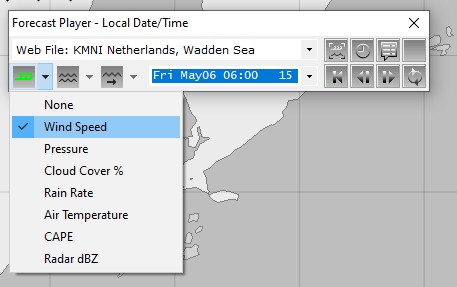
All forecasts are obtained as GRIB file downloads from various providers in EVOLUTION. In some cases, for free, but in others cases, under prepaid subscription plans (i.e., PredictWind and Tidetech).
Optimal Routing
With PredictWind’s Offshore PC application installed on the same PC as EVOLUTION, you can take advantage of the world-leading optimal weather routing. You can download the app for free from:
https://www.predictwind.com/apps/offshore-app/
The Weather Routing is calculated on the PredictWind server based on six world-class forecasts with the highest resolution data. The resulting file size is tiny, making it ideal for onboard reception over low-bandwidth satellite connections. Also, you can use it on land Wi-Fi as part of your pre-race strategy building, starting simulations days in advance.
Once you have obtained your final six optimal routes, EVOLUTION lets you import any of them, creating the corresponding “course” to follow.
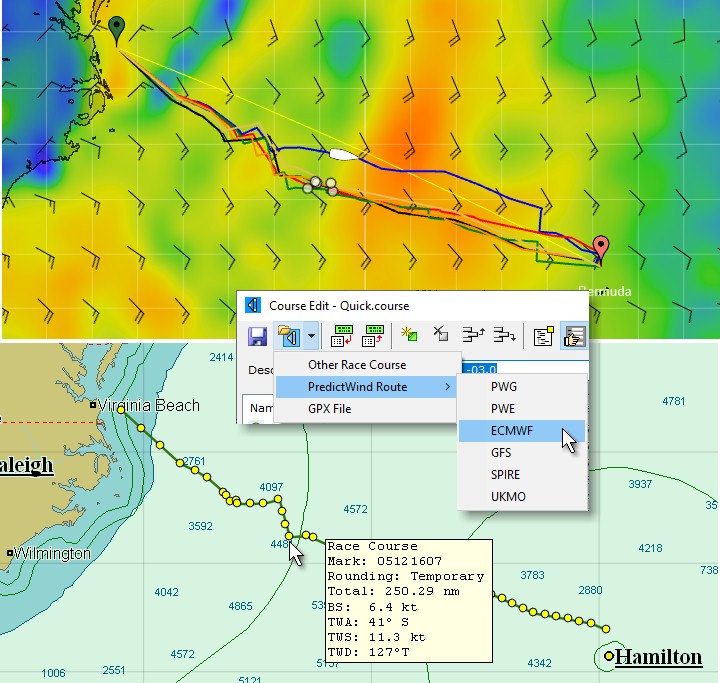
“You can improve only what you can measure.” Peter F. Drucker
One of the most powerful features of EVOLUTION is recording everything that happens while racing or testing for later analysis.
With this information, you can:
- Detect calibration problems and get the necessary corrections.
- Analyze performance data to refine the performance polars and sail crossovers.
- Check the crew’s skills related to the start, performance, tactics, and strategy.
- Identify the areas in which the team needs more training. For example, maneuvers, anticipating wind shifts, sail trimming, etc.
- Answer endless questions about tuning the boat.
- Analyze data over time. Identify strengths and weaknesses. Create and put in place consistent training programs.
- Speed up the learning curve to reach excellence as quickly as possible.
- Present the topics of the post-regatta meetings (debriefing). By replacing subjective opinions, the team can focus on solving what matters.
EVOLUTION stores the following information:
- All the data from the instrument and the suggested navigation parameters in optimal performance (targets, laylines, etc.).
- Events related to sails in use, crew members in critical roles, comments, and any parameter of interest. EVOLUTION provides a database to add sails, people, and parameters. Rigging settings, sea state, the volume of water and diesel in the tanks, or what you deem important.
- Video, image, and audio files. You can visualize how the sails are trimmed and how the crew executes each maneuver.
- If the race allows satellite trackers, the system will store all competitors’ positions.
EVOLUTION saves each race or trial in an easy-to-access catalog.
Replay Mode – Replay from Log
You can put the entire system playback mode for any regatta or test. You can fast-forward, rewind, play at different speeds, and stop the action anytime. If you have entered events, you can access them.
You will see everything as it happened during the navigation, including the start, the performance, tactics, and wind behavior.
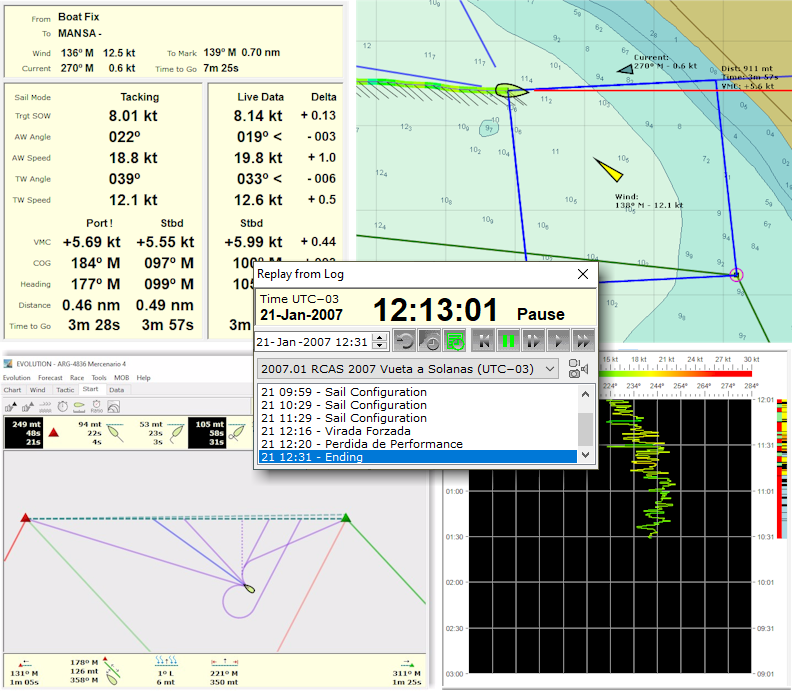
Video, Images, and Audio
EVOLUTION has a powerful new feature. Now you can add video, image, and audio files and play them in sync with the other data.
The videos can come from different devices (GoPro, drones, or smartphones) and in various file formats (mp4, mp3, avi, wmv, etc.). To save storage space, you can use time-lapse techniques.
EVOLUTION can display these files in different windows. Using multiple displays is an excellent option.
You can check out this feature in this short clip…
With this function, you can:
- Visualize each maneuver or the trim of the sails and how they affect the boat’s performance. This is an excellent tool for creating training programs and evaluating their results.
- Analyze how your team makes decisions. Audio tracks will help you understand how the crew uses information and streamline these practices.
- Provide evidence in the event of a protest. You can present compelling facts by replaying the boat’s track and videos.
Numerical Analysis
You need precise numbers to calibrate your instruments or check the boat’s polar curves. Or you might want to review maneuvers and tactical decisions. EVOLUTION gives you the ability to extract numerical information. You may:
- Create and save multiple data groups for a specific purpose.
- Select from over 100 timeline indicators reports comparing the ideal vs. reality.
- Export this data by selecting significant sections on the chart.
- Analyze the information obtained in simple tools such as Microsoft Excel.
- If your project requires it, you can export data to the following services:
https://www.sailingperformance.com
EVOLUTION provides reports to manage continuous improvement processes, from calibration to evaluating starts, strategies, maneuvers, tactics, and fleet performance.
Navigation is a risky act. Even while racing, using official nautical charts and publications, planning a safe route, and respecting the laws and regulations are all essential. The captain must always use all available information in a timely and prudent way.
Although EVOLUTION is a specific system for racing, it provides modern navigation functions. It uses vector cartography and provides a complete set of piloting tools.
Vector Cartography
EVOLUTION uses nautical charts from the firm C-MAP. Their cartography is recognized worldwide for its quality and global coverage. They are updated from information the national hydrographic offices provided and specially oriented to sports navigation. These charts are a detailed, precise, and faithful representation of traditional marine charts.
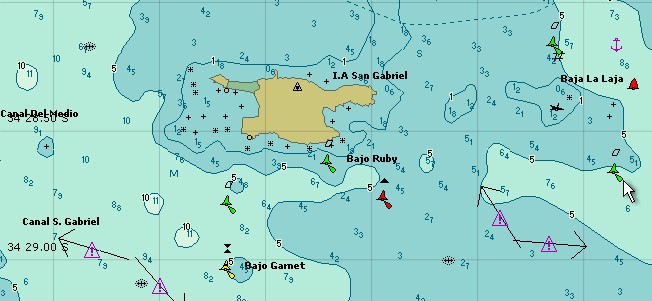
EVOLUTION allows you to show or hide chart items by categories or adjust the color scheme. To simplify the selection of an option set, you can name them at your will (sailing, regatta, weather, day, night, etc.)

The system includes worldwide shoreline cartography, which you can view in a gnomonic projection. In this projection, distances at high latitudes are not distorted as in a Mercator projection.
By the way, EVOLUTION navigation is always orthodromic (great circle).
Racecourses, Marks, and Waypoints
We must always enter a route to follow in tactical (race) or traditional navigation.
As a system designed for yacht racing, the names we use in chart plotters or GPS units change. Routes are racecourses (or courses), and waypoints are marks. The tactic mark is our immediate destination for which the system solves all tactical calculations. This is the same as the “go-to waypoint” in the GPS world.

EVOLUTION provides streamlined tools to create and manage racecourses by setting marks on the chart or entering them on a form. You can import courses and waypoints from various formats and load marks from points generated by the Predictwind Offshore app’s optimal routing system.
The system does contain a library of “points of interest” called waypoints. Using their positions, you can easily add marks to a racecourse.
Keeping each crew member and the boat safe in any sailing condition is the skipper’s and team’s main priority.
Beyond reliable weather forecasts and nautical charts, EVOLUTION provides a set of functions for safety on board.
- AIS potential collision alarm. It is a distance from our boat (CPA) and a time before a ship would reach this safety margin (TCPA).
- AIS perimeter guard alarm. It is set as a distance around our boat and is triggered by any ship entering this area.
- AIS search and rescue (AIS-SAR) alarm. The activation of a personal AIS-SAR beacon sets it off.
- “Man-over-board” positioning button. Sets the position of a MOB on the chart. Provides bearing and distance to return and rescue.
Automatic Identification System (AIS)
EVOLUTION extensively uses the Automatic Identification System (AIS), both as a tool to avoid collisions with ships and for man-overboard recovery.
Connected to an AIS receiver, EVOLUTION monitors vessel traffic, identifying potential risks. You can set the risk levels for each type of navigation, indicating when the system should sound the alarms.
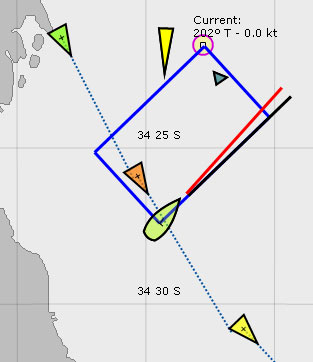

Search and Rescue AIS (AIS-SAR)
This technology integrates a GPS and an AIS transmitter in a miniaturized personal device. They are attached to each life preserver and automatically activated when it is inflated. They begin transmitting the person’s GPS position, displaying their location on an AIS-capable display and any DSC-equipped VHF radio.
This safety equipment is now included in Sailing World’s Offshore Special Regulations (OSR). For an offshore race, each crew member must carry a personal AIS-SAR.
When one or more personal AIS-SAR are activated, EVOLUTION sounds the MOB alarm and indicates the direction and distance to each target. You can find your partner’s location with complete accuracy in any weather. The typical range of the signal is 2 or 3 nautical miles.
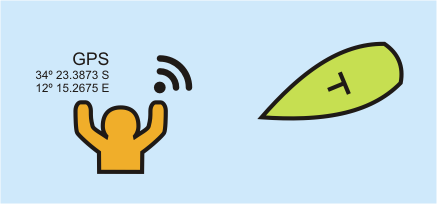

MOB Button
Using a simple button, EVOLUTION marks the man’s overboard position and displays all the necessary data to return to that point. The system provides an alternate position by applying the current’s drift.
